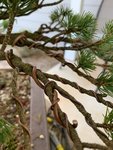So, since I’m wiring this morning, I thought i’d also show an advanced technique: deliberately crossing wires!
What!?! Aren’t we all taught to never cross wires? Well, yes, we are. And that’s a good basic rule to follow in most cases. Running wires parallel looks neater and doesn’t create hot spots where wire can dig in.
Yet, there are cases where crossing wires is a good technique. Particularly when you need to splice a smaller wire to a larger wire. Let’s say you are wiring a branch with large wire, and the branch gets thin, too thin to continue all the way out with the thick wire. So, find a convenient place to end it with a bit of fish-hook. When bringing the thinner wire along parallel to extend the wire past the end of the thicker wire, about one turn before the thick wire ends, cross over the thick wire. Bring the small wire back around, and continue down the branch. What this does is lock the two wires and branch together as one.
Here’s a picture of where I’ve done it, once in the foreground, and once in the back ground:
View attachment 260781


